Related Research Articles
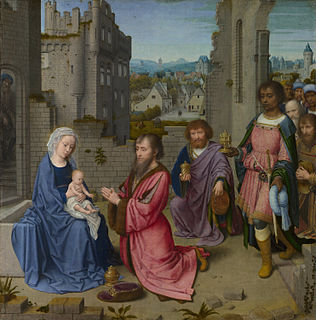
The Adoration of the Magi or Adoration of the Kings is the name traditionally given to the subject in the Nativity of Jesus in art in which the three Magi, represented as kings, especially in the West, having found Jesus by following a star, lay before him gifts of gold, frankincense, and myrrh, and worship him. It is related in the Bible by Matthew 2:11: "On entering the house, they saw the child with Mary his mother; and they knelt down and paid him homage. Then, opening their treasure chests, they offered him gifts of gold, frankincense, and myrrh. And having been warned in a dream not to return to Herod, they left for their own country by another path".

The Adoration of the Shepherds, in the Nativity of Jesus in art, is a scene in which shepherds are near witnesses to the birth of Jesus in Bethlehem, arriving soon after the actual birth. It is often combined in art with the Adoration of the Magi, in which case it is typically just referred to by the latter title. The Annunciation to the Shepherds, when they are summoned by an angel to the scene, is a distinct subject.
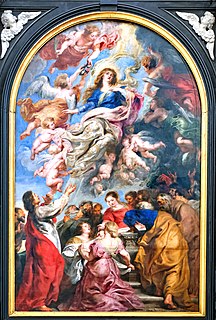
The Assumption of the Virgin Mary does not appear in the New Testament, but appears in apocryphal literature of the 3rd and 4th centuries, and by 1000 was widely believed in the Western Church, though not made formal Catholic dogma until 1950. It first became a popular subject in Western Christian art in the 12th century, along with other narrative scenes from the Life of the Virgin, and the Coronation of the Virgin. These "Marian" subjects were especially promoted by the Cistercian Order and Saint Bernard of Clairvaux.

The Royal Museum of Fine Arts Antwerp is a museum in Antwerp, Belgium, founded in 1810, houses a collection of paintings, sculptures and drawings from the fourteenth to the twentieth centuries. This collection is representative of the artistic production and the taste of art enthusiasts in Antwerp, Belgium and the Northern and Southern Netherlands since the 15th century. The museum has been closed for renovation since 2011.
Alfred E. Allnatt, known professionally as Major A.E. Allnatt, was an English businessman. He took over his father's supply business and developed it into Allnatt London Properties and other well-known businesses in England.
Events from the year 1609 in art.
Events from the year 1617 in art.
Events from the year 1634 in art.

The Nativity of Jesus has been a major subject of Christian art since the 4th century.
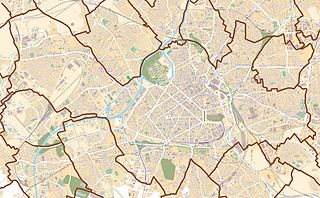
The Palais des Beaux-Arts de Lille is a municipal museum dedicated to fine arts, modern art, and antiquities. It is one of the largest art museums in France.

Sir Peter Paul Rubens was a Flemish artist and diplomat from the Duchy of Brabant in the Southern Netherlands. He is considered the most influential artist of the Flemish Baroque tradition. Rubens's highly charged compositions reference erudite aspects of classical and Christian history. His unique and immensely popular Baroque style emphasized movement, colour, and sensuality, which followed the immediate, dramatic artistic style promoted in the Counter-Reformation. Rubens was a painter producing altarpieces, portraits, landscapes, and history paintings of mythological and allegorical subjects. He was also a prolific designer of cartoons for the Flemish tapestry workshops and of frontispieces for the publishers in Antwerp.

The Adoration of the Magi is a painting of 1632–34 by the Flemish Baroque artist Peter Paul Rubens, made as an altarpiece for a convent in Louvain. It is now in King's College Chapel, Cambridge, in England. It measures 4.2 m × 3.2 m.

Paulus Pontius was a Flemish engraver and painter. He was one of the leading engravers connected with the workshop of Peter Paul Rubens. Ater Rubens' death, Pontus worked with other leading Antwerp painters such as Anthony van Dyck and Jacob Jordaens.

The Adoration of the Magi is a very large oil painting by the Flemish Baroque painter Peter Paul Rubens. He first painted it in 1609 and later gave it a major reworking between 1628 and 1629 during his second trip to Spain. It is now in the Museo del Prado in Madrid.
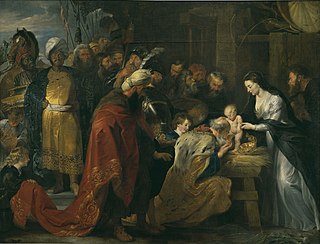
The Adoration of the Magi is a c.1617-18 painting by Peter Paul Rubens. It is now in the Musée des Beaux-Arts de Lyon

The Adoration of the Magi is a 1624 oil on canvas painting by Peter Paul Rubens, measuring 218 cm by 280 cm. It was commissioned by Matthæus Yrsselius, abbot of St. Michael's Abbey, Antwerp, as an altarpiece, and paid for in two instalments of 750 guilders each in 1624 and 1626. The Virgin Mary is thought to have been modelled on Rubens' first wife Isabella Brant. The painting is now in the Royal Museum of Fine Arts Antwerp.

Matthæus Yrsselius or Irsselius, the Latinized form of Mattheus van Iersel (1541–1629), was abbot of St. Michael's Abbey, Antwerp, from 1614 until his death. He was remembered as a patron of the arts and sciences.
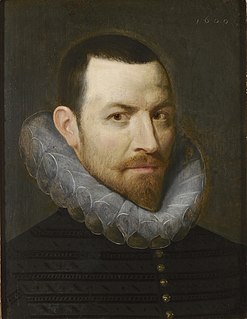
Nicolaas Rockox (1560–1640), was a mayor of Antwerp. He was a close personal friend and important patron of Peter Paul Rubens. His residence in Antwerp is now a museum known as the Rockox House. He was knighted by Archdukes Albert and Isabella, the Governor General of the Southern Netherlands.

Nicolaas Peter Paul Rubens, Lord of Rameyen (1618–1655) was a son of the painter Peter Paul Rubens and Isabella Brant.

The Adoration of the Magi, is a circa 1645 oil on panel painting of the Nativity by the Dutch artist Salomon Koninck in the collection of the Mauritshuis in The Hague.
References
- ↑ Hans Devisscher, Peter Paul Rubens: Aanbidding der Koningen (1992) noted ten versions of the theme and Michael Jaffé, Rubens: Catalogo completo (Milan, 1989) fifteen.